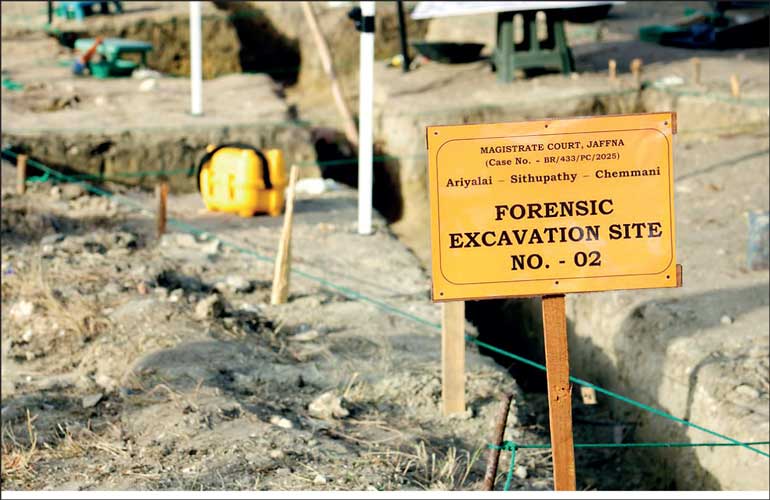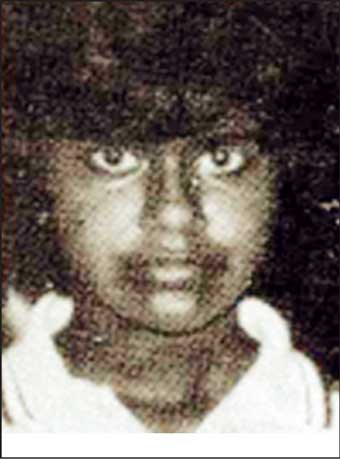Saturday Dec 27, 2025
Saturday Dec 27, 2025
Friday, 18 July 2025 00:30 - - {{hitsCtrl.values.hits}}

The Chemmani earth is speaking out again after so many years
 Chemmani, a sparsely populated area in the northern peninsula of Jaffna has in recent times acquired a somewhat dubious image. Just as Nallur in Jaffna is associated positively in public perception with the famous Kandasamy temple, Chemmani is associated negatively with mass graves. The long war between the Sri Lankan armed forces and the Liberation Tigers of Tamil Eelam (LTTE) has resulted in innumerable instances of enforced disappearances and extrajudicial killings. The mass graves uncovered in Chemmani are symbolic proof of those disappearances and killings.
Chemmani, a sparsely populated area in the northern peninsula of Jaffna has in recent times acquired a somewhat dubious image. Just as Nallur in Jaffna is associated positively in public perception with the famous Kandasamy temple, Chemmani is associated negatively with mass graves. The long war between the Sri Lankan armed forces and the Liberation Tigers of Tamil Eelam (LTTE) has resulted in innumerable instances of enforced disappearances and extrajudicial killings. The mass graves uncovered in Chemmani are symbolic proof of those disappearances and killings.
In July 1998, Corporal Somaratne Rajapaksa and some other soldiers were convicted for the rape and murder of a Jaffna schoolgirl Krishanthi Kumaraswamy and the killing of her family. Rajapaksa revealed at his sentencing that between 300 and 400 Tamil civilians killed in 1996 were buried in the Chemmani area.
This disclosure resulted in excavations in 1999 that yielded 15 skeletons, two of which were identified as of youths made to disappear in 1996. Despite forensic confirmation of assault and execution, there was no follow up prosecution. Justice was not meted out. The uncovered human remains taken to the University of Glascow for analysis are still in Scotland.
On 13 February this year, construction workers uncovered human skeletal remains at the Sithuppaathi Hindu cemetery in the Chemmani area. They were engaged in a project to re-develop the cemetery. The Jaffna Magistrate’s Court formally declared the site a mass grave and ordered a court-supervised excavation under judicial scrutiny.
67 skeletons including those of infants and children have been exhumed so far. Several personal artefacts such as a schoolbag, a toy doll, bangles, sandals and fragments of clothing have also been discovered. Currently excavation has ceased but will be resumed from 21 July.
The discovery of skeletal remains of over 60 people including infants and children along with the discovery of artefacts like a school bag and toy doll have made a profound impact on the Tamil people. It appears that the skeletal remains are those of Tamil civilians. Many Sinhalese too have expressed their horror over the discoveries. It is believed that the human remains being uncovered at Chemmani belong to the hundreds of civilians made to disappear in 1996. The Chemmani earth is speaking out again after so many years!
What happened in 1996 was this. The LTTE had been in control of the Jaffna peninsula and the greater part of the Northern mainland since 1990 after the Indian army departed from the North and East. Chandrika Kumaratunga was elected president on a platform of peace in 1994. Initially there was a ceasefire and negotiations commenced between the Kumaratunga Government and the LTTE. However the Tigers went to war again in April 1995.
“Operation Riviresa”
The Sri Lankan army launched a phased out military offensive codenamed “Operation Riviresa” which resulted in the re-capture of the Jaffna peninsula from LTTE control. The LTTE engineered a mass exodus of Tamil civilians from the Peninsula into the Northern mainland known as “Wanni”. Although this engineered exodus was partly successful, a very large number of Tamil civilians opted to remain in their homes in Jaffna and take their chances with the armed forces.
Nimal Siripala de Silva
 |
| Krishanthi Kumaraswamy |
Initially the armed forces while establishing their authority also tried to win the hearts and minds of the Tamil people in Jaffna. It was believed that the LTTE presence had been eradicated in Jaffna. The Government wanted to commence a program of re-construction in war ravaged Jaffna. The then minister of Housing and Construction Nimal Siripala de Silva undertook a visit to Jaffna. He was the head of the Presidential Task Force on Northern rehabilitation and re-construction. A public meeting was held in Stanley Road, Jaffna with Minister Siripala de Silva attending as chief guest and the then Jaffna town commandant Brig. Ananda Hamangoda presiding.
What the Government and the Army top brass did not realise was that the LTTE had been infiltrating the Jaffna peninsula clandestinely. They had blended with the population and were planning strikes. The LTTE announced its return with a “bang” literally and metaphorically. A woman strapped with explosives exploded herself near the vehicle in which the minister and Brigadier were leaving after the 4 July meeting. Though Nimal Siripala de Silva was the prime target, the minister escaped with injuries. But 23 others including Brig. Hamangoda were killed. Subsequently Hamangoda was promoted posthumously as Major-General.
Two weeks later the LTTE struck again this time in the Northern mainland. The LTTE attacked the Mullaitheevu army camp on 18 July 1996. The camp was overrun and hundreds of soldiers were killed.
Aggressive campaign
The two attacks in July 1996 changed the politico-military environment especially in Jaffna. The winning of hearts and minds approach in Jaffna was abandoned. Instead an aggressive campaign to clean Jaffna of Tigers commenced. Since the LTTE was suspected of swimming like fish in an ocean of Tamil people, civilians were subjected to much hardship.
Several people mostly youths were arrested or made to disappear. It was as if an unofficial license had been given to defence personnel to target Tamil civilians and engage in mass scale human rights violations. Consequently over 600 enforced disappearances were recorded during this phase.
Chemmani soil’s dark secrets
It was in this situation that Chemmani got identified with mass graves. As stated earlier it was Cpl. Somaratne Rajapakse who first disclosed in 1998 that hundreds of civilians had been buried in mass graves in Chemmani in 1996. Fifteen skeletons were exhumed in 1999. Now decades later more skeletal remains were being exhumed. It seems that buried in the soil of Chemmani are many dark secrets waiting to be unearthed if Governments in power have the political will to do so.
The Chemmani mass graves matter has also evoked much interest in the Krishanthi Kumaraswamy murder and rape case. It was the first accused in that case Corporal Rajapakse who first raised the spectre of Chemmani mass graves in court after being convicted. There is much mention of Krishanthi Kumaraswamy these days and a lot of interest in knowing what happened to her then. It is against this backdrop that this column focuses on the tragedy of Krishanthi Kumaraswamy in this two-part article.
Brilliant student
 The tragic tale began on 7 September 1996 when Krishanthi Kumaraswamy an 18-year-old student of Chundikuli Girls High School, a prestigious educational institution run by the Anglican Church in Jaffna, was returning to her home at Kaithadi. Krishanthi was a brilliant student who had obtained eight distinctions at the GCE O/L. (She was currently sitting for her A levels. She had obtained “A” in the two subjects she sat for before her life was cut short). Her ambition in life was to make her mother happy by becoming a medical doctor. She used to cycle to school and back daily.
The tragic tale began on 7 September 1996 when Krishanthi Kumaraswamy an 18-year-old student of Chundikuli Girls High School, a prestigious educational institution run by the Anglican Church in Jaffna, was returning to her home at Kaithadi. Krishanthi was a brilliant student who had obtained eight distinctions at the GCE O/L. (She was currently sitting for her A levels. She had obtained “A” in the two subjects she sat for before her life was cut short). Her ambition in life was to make her mother happy by becoming a medical doctor. She used to cycle to school and back daily.
After sitting for her AL chemistry paper on 7 September 1996, Krishanthi along with a friend Gauthami Sundaram visited the home of a classmate Janaki who had died in an accident the previous day. She had been knocked down by an army vehicle. Thereafter Krishanthi and Gauthami parted ways and Krishanthi proceeded home on her cycle.
Krishanthi was fatherless. Her mother 59-year-old Rasamma Kumaraswamy was a graduate teacher and school vice principal. Kushanthi’s 20-year-old sister Prashanthi was studying accountancy in Colombo. Her younger brother, 16-year-old Pranavan was a student at St. John’s College. The family with the exception of the elder daughter were residents of Kaithadi, a village in the Thenmaratchchi Division of Jaffa.
Kaithadi
Kaithadi is virtually on the border of Thenmaratchchi in close proximity to Navatkuli although the Jaffna lagoon separates a greater part of both places. Adjacent to Navatkuli is Ariyalai from where the Jalina municipality limits begin. An archway saying “Jaffna welcomes you’ demarcates the municipal area from Thenmaratchchi on the Jaffna-Kandy road. A road from this point leads to Nallur via Chemmani, Nayanmarkattu and Kalviyankadu.
Another road from the Maambalam junction at Ariyalai also cuts through Chemmani. This area is sparsely populated with large chunks of marshlands. The greater part of Chemmani including these marshlands was in those days a high security zone and declared a no-go area for civilians because of the presence of army camps in the vicinity.
Checkpoint
There was a checkpoint-cum-sentry post on the Jaffna-Kandy road on the Ariyalai-Chemmani-Navarakuli border. Technically the security post was located in the general area of Chemmani. Krishanthi had been cycling to and from Jaffna through this check post for quite some time. As someone who passed by the check post regularly, Krishanthi was usually not subjected to checking or questioning. However on her way back on that fateful day, she was stopped and taken inside the bunker of the check post for questioning. Krishanthi was told that she was ‘a Tigress’ and had to be interrogated intensively.
When this so-called interrogation was going on, other residents of Kaithadi also happened to pass through the same point. There is evidence that Krishanthii was heard pleading with the soldiers and policemen on duty, that she was not an LTTE member at all. She had cited her O Level qualifications and the fact that she was doing her A Levels and said that her only aim was to enter university. She told the soldiers she had no father and that her only ambition in life was to become a doctor and make her mother happy. She stated vehemently that she was not interested in politics at all. A pathetic plea she made was, “We trusted you and came back to live here. Why are you doing this to me?”
All those words had no effect on her interrogators. Psychoanalysts may also conclude that the middle class, intelligent and articulate Krishanthi symbolised the bourgeois Tamil image to the rustic Sinhala soldiers who were now of the ‘powerful” class. In that context, the desire to demonstrate their authority may have been overwhelming. Whatever the motivating factors, Krishanthi Kumaraswamy was never seen alive after that day.
Worried mother
The mother Rasamma got worried as her daughter had not returned home even in the afternoon. She got information from some people of Kaithadi that Krishanthi had been detained at the Chemmani checkpost. This was confirmed to Rasamma by a 35-year-old trusted neighbour Chidambaram Kirubamoorthy. So the mother, brother and the good hearted neighbour, Kirubamoorthy got on their cycles (the most common mode of transport in Jaffna then) and made their way to the checkpost. Rasamma seated herself on the bar of her son’s cycle. Kiruba rode his own cycle.
They arrived at the checkpoint around 3 p.m. and were seen asking those on duty there about the whereabouts of Krishanthi. Thereafter all three went “missing”. A family and their neighbour had ‘vanished’.
Some others in Kaithady went to some military posts in Chemmani and Ariyalai, the following day and asked about the family. “Officialdom” denied having any knowledge of Krishanthi, her family and neighbour.
Joseph Pararajasingham
But news about this ‘disappearance” began spreading and percolated down to Colombo. A Tamil lawyer who was Krishanthi’s relative was informed of this by her sister. Then other Tamil lawyers, politicians and human rights activists also became aware. Former TULF Batticaloa MP Joseph Pararajasingham raised the issue in Parliament on 13 September 1996. Former deputy defence minister Anuruddha Ratwatte replied that he will look into the matter. Pressure was exerted on the Government at the highest level by several diplomats in Colombo who displayed great concern in the matter.
Neelan Tiruchelvam
Former TULF National list MP Dr. Neelan Tiruchelvam gathered available details of the incident and prepared a document. He got an appointment with the then President Chandrika Kumaratunga and presented the document. To her credit President Kumaratunga was sympathetic and receptive. Since the “disappearance” had occurred in an area controlled by the Army, the Government was accountable, opined Chandrika. As a result immediate action on the matter was ordered by President Kumaratunga.
Prashanthi Mahindaratne
Unlike in other cases of human rights violations, the State and its organs did not seek to cover up the matter in this instance. The Attorney-General’s department and the military police division of the Army collaborated in the mission to find out what exactly had happened. The then A-G Sarath Nanda Silva assigned a young state counsel Prashanthi Mahindaratne to the case. She worked under the guidance of former Solicitor General D.P. Kumarasinghe.
Prashanthi Mahindaratne relocated to Jaffna and started working on the case. She was given the fullest cooperation and assistance by the then head of the military police in Jaffna Col. Kalinga Gunaratne. There was also a team of Police officials from the Criminal Investigation Department (CID) engaged in the investigation.
As the investigation got underway those on duty at the check point on 7 September were rounded up for questioning. There were eight soldiers and three reserve Police constables on duty at the checkpoint. The intensive questioning yielded positive results. The investigators received valuable information about a particular spot in Chemmani. A buried cycle was found first. Then came the major discovery. The decomposed bodies of Krishanthi, her mother, brother and neighbour were discovered. Krishanthi’s body had been chopped while the others had been strangled to death. The bodies were exhumed in late October.
Two state witnesses
Initially indictments were served on all 11 persons on duty at the check post on that particular day. Of these, two turned state witnesses, a most welcome development from the point of view of the prosecution as otherwise there would have been no eyewitness testimony to most of what had happened on that day.
The two state witnesses were two Policemen on duty on 7 September. They were reserve Police constables P.A. Samarawickrema and A.H. Nazaar. Both of them were given conditional pardons as they were not involved directly in the rape or murders. They had only been involved in disposing of the bodies. Subsequently, nine persons consisting of eight soldiers and one policeman were charged under trial at bar proceedings without a jury.
Nine indicted
The nine accused comprised eight soldiers and a reserve police constable. They were:
Corporal Somaratne Rajapakse (1st),
Mudianselage Jayasinghe (2nd),
RPC Pradeep Priyadharshana (3rd),
Priyantha Perera (4th),
Wijayananda Alwis (5th),
D.G. Muthu Banda (6th),
Lance Corporal Mudianselage Jayatileke (7th),
D.V. Indrajith Kumara (8th)
and Pathiranalage Nishantha (9th).
They were charged under sections 140, 146, 296 and 357 of the penal code for the alleged offences of being members of an unlawful assembly, abduction, rape and murder. These charges related to Krishanthi. The accused were further charged with abducting and committing the murders of Krishanthi’s mother, younger brother and neighbour at the same time.
Trial-at-bar
The trial-at-bar commenced in November 1997 in Colombo. The three-member bench comprised high court judges Nimal Dissanayake, Gamini Abeyratne and Andrew Somawansa. The legal spade work was done by State Counsel Prashanthi Mahindaratne. Later, Additional Solicitor General D.P. Kumarasinghe added stature to the prosecution by becoming chief counsel for the state.
As the case progressed, the fifth accused Wijayananda Alwis died in custody due to meningitis. There were accusations of neglect by the prison authorities. The 9th accused Pathiranalage Nishantha was discharged for want of strong evidence in the early days of the trial. The 6th accused DG Muthubanda was acquitted on Judgement day because the court held that the evidence against him was not substantial.
During the trial, two of the accused escaped from court in a manner that smacked of connivance with those detailed to guard them. One of them, the first accused Corporal Somaratna Rajapakse, was apprehended at Ratnapura after some days. The other escapee, 8th accused DV Indrajith Kumara was never caught and is still at large.
Although the indicted offenders were all security personnel, the facts of the case made it clear that these crimes were not committed in the heat of battle or in its immediate aftermath. This was not done in retaliation for some LTTE attack. The perpetrators were not engaged in genuine action aimed at arresting suspected Tigers at the time. Instead it was a low crime of rape and murder, compounded further by the killing of the entire family to cover up that crime.
Comprehensive verdict
The judges delivered on 3 July 1998, a comprehensive verdict against all six persons convicted including the absconding soldier. The details of the sentences imposed, as well as information about how the investigation into the Krishanthi Kumaraswamy rape and murder case was conducted, would be related in the second part of this article.
(The writer can be reached at [email protected].)